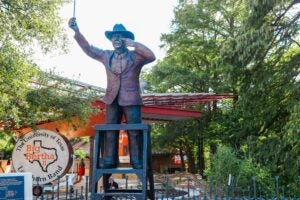Once upon a time, before the 20th century, most people didn’t have the luxury of dying from causes under their control.
They got an infection or suffered a serious injury and that was that–they were gone before reaching the august age of 30. Folks didn’t live very long because the science knowledge to save them didn’t exist.

Out of the whole history of human endeavor, it’s a fairly new phenomenon to be spending around $75 billion of the national budget on costs for chronic diseases and deaths that arise because we lie in front of the TV every night of the week or drive a block and a half to rent a DVD instead of walking. Or smoke three packs a day and eat too much good-tasting bad food because it’s there and we can.Our lifestyles are killing us–and costing us–with sedentary habits being one of the biggest contributors. As epidemiologist and physical activity expert Dr. Bill Kohl puts it, we’ve engineered physical activity right out of our lives, and that’s not natural.”Until very, very recently people’s existence demanded and naturally included physical exertion,” says Kohl, who left the Centers for Disease Control and Prevention (CDC) in Atlanta to take a joint position with The University of Texas at Austin and University of Texas School of Public Health. “They might walk several miles a day to reach a neighbor’s house or get to church or school. They engaged in physical labor to produce or hunt for their food and in more physical labor than we do to prepare it, wash clothes and build their houses. Human animals were made to move, and our more ‘civilized’ lives are, in that respect, an aberration.”Kohl knows of which he speaks. At the CDC, he was team leader for epidemiology and surveillance in the physical activity and health branch of the Division of Nutrition, Physical Activity and Obesity.In fall 2006, the U.S. Department of Health and Human Services asked him to help create the first national physical activity guidelines, and in 2008, after an exhaustive scouring of the latest scientific research, the Physical Activity Guidelines for Americans were released. They’re the current gold standard in comprehensive physical activity guidance and are the equivalent of the national Dietary Guidelines, known to most as the “food guide pyramid.”Kohl’s joint position as professor in the College of Education‘s Department of Kinesiology and Health Education at The University of Texas at Austin as well as the University of Texas School of Public Health’s Michael and Susan Dell Center for Advancement of Healthy Living delivers a one-two punch.On the kinesiology side, Kohl works with scientists who are studying what happens in the body at a cellular level when we exercise and how exercise reduces cholesterol or increases bone density and improves mental health. They’re discovering and describing the science behind obesity, weight loss, recovery after a strenuous workout and prevention of chronic diseases.”The first step is to have good science to back up any recommendations and guidelines that we make,” says Kohl. “Someone asked why physical activity guidelines weren’t developed before 2008 and I would have to say that one of the major reasons is that the scientific support for many things just was not there or wasn’t advanced enough. The field is maturing at warp speed, though, and we now know so much more than we did even five years ago.

“It’s crucial to find out as much as we can about the physiological basis behind the exercise and aging processes and obesity and to be able to explain the ‘how’ and ‘why’ to people. We feel comfortable saying that adults need at least 150 minutes of moderately vigorous exercise a week. That’s because we derived that figure from some strong, targeted scientific studies.”
On the public health side, Kohl’s expertise as an epidemiologist comes into play as he looks at data on behavior trends in populations and relates that to health outcomes. What makes some communities or parts of the country healthier, overall, than others? What messages motivate people to integrate physical activity into every day of their lives? Are children who attend schools that offer more opportunities for physical activity actually healthier over the long term?
What will help people change their behavior?
In the past few months, Kohl has become involved in an exciting project that may sort of answer that last question. With a grant from Austin/Travis County Health and Human Services he’s studying health changes in people who live in and around a new neighborhood in East Austin, an eco-friendly, cool-concept spot that’s designed to move you.
“The neighborhood that’s being developed where the old Mueller Airport once stood embraces the precepts of New Urbanism,” says Kohl, “which is to say that the area is being built, from the ground up, with a focus on sustainability, reusability, renewable resources–‘green living’ overall, with the least possible negative impact on the environment.
“The designers and architects of this neighborhood didn’t set out, when they were developing the layout of the built environment and physical features, to encourage weight loss and physical fitness. The fact that people probably will walk and bike if stores, restaurants, safe hike-and-bike trails, parks, ponds and schools are in walking and biking distance and there are lots of trees and sidewalks is just more good news. This neighborhood, as it unfolds and grows, is going to inform Austin and cities around the nation when they plan iterations of the Mueller community. There just aren’t that many like it anywhere.”

Kohl and doctoral student Tamara Vehige will be conducting a pilot study on possible health benefits of being in an environment conducive to movement and seeing how the Mueller community influences–or if it influences–the health and habits of those who live around it. For Kohl and other scientists, the neighborhood will be a “long-term living lab.”
“Neighborhoods like the Mueller one have ecological benefits and health benefits, but if those features don’t manage to sell someone on the idea,” says Kohl, “you have the economic benefit as well. Cities and communities that are designed around healthy living may hold their value better. This even applies in cities with no smoking ordinances. In addition to all of the other reasons, the value argument can be applied when you’re talking about improving environmental features of communities.”
The Mueller area development is a from-the-ground-up project, which means that many eco- and health-friendly details have been incorporated that might not be financially or logistically possible for an already established community. There are, however, several feasible “street level” changes that any neighborhood can adopt to encourage people to venture out and be more physically active.
According to Kohl, wide sidewalks in good repair encourage foot traffic, as do streets that have clearly marked walkways at intersections, speed limits posted at frequent intervals and speed control features on street surfaces. In addition to benefiting physical health, the migration of people from their couches and computers to the outdoors can improve their mental and emotional health.
In the Mueller neighborhood, all of the homes have front porches and not many have fenced back yards, which would isolate residents. The idea is to encourage people to meet and get to know their neighbors and develop a sense of community. This enhancement of “social capital” (when people acquire a sense of ownership regarding the quality of their surrounding environment) has been found to improve individuals’ overall feelings of well-being.

“The environmental aspects of physical activity and fitness have made exercise into a public health issue,” says Kohl. “Grandma knew that carrots were healthier than carrot cake with cream cheese icing, but eating more healthfully becomes a public health issue when we start making environmental changes to elicit those big, meaningful changes in behavior and improvements in health.
“In the ’30s and ’40s, almost everyone brushed their teeth with baking soda and that was about the best they could do in the way of oral health. It wasn’t until water supplies started being fluoridated that we actually saw population improvements in oral health, though. As far as obesity and inactivity on a national scale, where’s our fluoride? What do we need to do to see large-scale desirable changes?”
To change America’s dismal health report card, Kohl is a firm believer in changing children’s habits. According to Kohl, children need to grow up seeing daily physical activity as pleasurable and as a natural thing, like sleeping or eating. He points out that you can tie anybody to a treadmill at the same time every day and make them walk for 30 minutes or an hour, but when you untie them, is that person going to jump back on the treadmill and enthusiastically exercise–every day? Highly unlikely.
“Kids like video games because video games are fun,” says Kohl. “Physical activity needs to be fun or children aren’t going to want to engage in it. It’s not about coming up with a structured, timed, enforced regimen of exercise and having them feel as though they’re part of a chain gang. It may be as simple as just encouraging them to go outside and play–play is exercise.
“Children need an hour a day of physical activity. If you have children and you want to help them get this activity in, you need, first of all, to be modeling non-sedentary habits yourself. That’s especially important. You also need to look at the physical education programs at the children’s schools. It’s not that PE classes are going to solve all of the problems–they may, at most, be able to keep a child’s heart rate up for around 20 minutes a day. They can’t provide an hour of exercise, but it should be a place where the children are active for most of the class and where activity is fun.”
Kohl also proposes that teachers and school administrators serve as role models. Teachers could form walking groups and use trails or a track near the school during breaks or after school, and athletic shoes could be acceptable, even encouraged, school attire for teachers and principals.

Physical fitness themes and messages could be incorporated across the curriculum and, when possible, math, science, history and English lessons could include movement. Art students could produce posters and drawings of fitness-focused scenes to display around the school. Kohl also would like to see walking trails at schools for students to use during physical education classes.
Evidence-based physical education programs in schools, such as the University of Texas School of Public Health’s CATCH program, offer a persuasive argument that smart changes yield great health benefits. Among other things, model programs like CATCH feature physical education classes with up-to-date equipment and teachers trained in a coordinated approach to health.
“The whole field of studying physical activity, epidemiology and the effects of environment on health is pretty new,” says Kohl. “When it comes to physical activity as a public health issue, we’re about 40 years behind smoking and nutrition. There’s a lot to do, and we’re working on it, fast and furious. We need to convince policymakers and decision makers that the iceberg needs re-orienting.
“We need to train a whole new generation of research epidemiologists–which I’m doing now in my new joint faculty position–who will be experts on physical activity and do ground-breaking studies. Texas has to make ‘physical inactivity correction’ a top priority, and I’m working on this with the Governor’s Council on Physical Fitness, creating the same sort of state plan for physical activity that we have for diabetes, smoking, nutrition and heart health.”
And Kohl is riding his bike, being a good role model for everyone who spots him around The University of Texas at Austin campus, pedaling up hills and through clogged intersections.
“People in my field feel pretty comfortable saying that level of physical activity predicts who will live longer and who will die sooner,” says Kohl. “Putting it succinctly, ‘move for health’ just about sums things up.”



